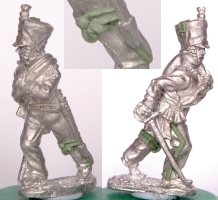
GMB 1811-issue flags for the Prinz Maximilian regiment (B&W image)
I’ve had my samples of the new 28mm Saxon line infantry flags from GMB since July and my orignal plan was to couple a review of them with some detailed historical background information. Two things threw a spanner in the works. The first was the inevitable intrusion of real life in the form of the Summer holidays; the second was a realization that the history of these flags from 1811 onwards is complex and obscure.
So I’m only going to tackle the easy, undisputed bit of the history of these flags in this posting: in 1807, King Friedrich Augustus ordered new flags for his line infantry regiments. It wasn’t however, until 16th July 1811 that he was able to formally present these new colours to the line infantry regiments in a ceremony at Muhlberg. Following re-organization of the army, each of the eight regiments of line infantry comprised two battalions of musketeers and two companies of grenadiers. A flag was presented to each of the 16 battalions of musketeers. The first battalion of each regiment received an Leibfahne (white background); the second battalion of each regiment received an Ordinarfahne (background in regimental facing colour).
If it wasn’t for the 1812 campaign in Russia, then the story of these flags would have probably remained quite simple. However, by the time the remnants of the Saxon army limped home, according to most sources, ten of the 16 flags had been lost. Piecing together which ones, where they were lost, what happened to them and, crucially, whether and how they were replaced in time for the 1813 campaign is where the complexities lie.
Now Peter F. and I are (with the help of several kind correspondents) slowly researching these questions and we hope to soon have access to several of the most reputable sources on the subject. In the meantime, Grahame’s first batch of flags cover those issued in 1811, so it seems suitable to press on with a short review of them here.
Above you can see a picture (converted to black and white to avoid naughty people exploiting Grahame’s hard work) of Pack SA5 which includes both the Leibfahne and the Ordinarfahne for the Prinz Maximilian regiment. The other packs cover 1811-issue flags the other seven line infantry regiments and there’s a gap in the numbering sequence which I presume is for the Lieb Grenadiers. In due course, I think Grahame hopes to make more flags to cover those issued to regiments that lost theirs in Russia.
The regimental facing colours were red, blue, green and yellow and interpretation of the precise shade is open to some conjecture in each case. For example, Grahame has chosen a darker mustardy yellow for the Prinz Maximilian regiment whereas, given the choice, I would have opted for a paler shade. That’s based on having sight of plates from Hottenroth’s 1910 book Geschichte der sächsischen Fahnen und Standarten (more of which on another occasion). But that’s a minor quibble and a personal preference.
There is, though, one historical error common to all the flags in this batch: the reverse and obverse of the flags are swapped the wrong way round. To be fair to Grahame, this is something he knows about and I know he’s been doing some soul searching about whether he should correct it. On the one hand, he’s as much a seeker of historical accuracy as Peter F.; on the other hand, he was a little worried about having to deal with customers who believe widely available English language sources that have perpetuated this error. I’m sure Grahame will read this and let me know which route he intends to follow. Plus, chances are that few people who look at your Saxon battalions won’t be knowledgeable enough to spot the mistake. Just don’t invite Peter F, Grahame or me to inspect your troops 🙂
Even German sources vary about some of the smaller precise details of the flags and the only way to be sure would be to be able to inspect the originals (where they still exist). So Grahame has had to make choices about which sources to follow – a tough decision because these are peculiarly detailed flags with many file details and variations. All of which also calls for a high level of draftsmanship and that’s where Grahame really excels. As usual with his products, the amount of detail that he packs into an area less than 30mm by 30mm is astounding.
So, overall then, Grahame’s produced a set of flags that uphold GMB’s reputation for making the best 28mm Napoleonic wargames flags on the market. And, barring minor issues, he’s achieved this while having to wrestle not only with the complexity of the design of these flags but the obscurity of historically accurate data.

 RSS 2.0 feed
RSS 2.0 feed

